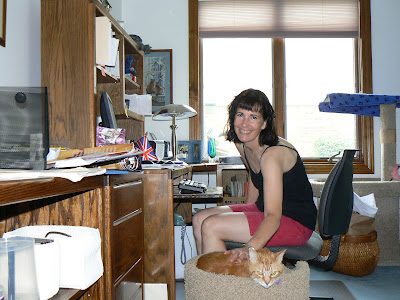
It's very nice: printer and supplies to my right, along with a window to the outside world where I can watch birdies on my finch feeder (or even better, watch my kitties watch the birdies). File cabinet, cameras, and media supplies to my left, and plenty of room to spread out research folders, books, and miscellaneous scraps of paper listing other things to be done. [edited to add: I am a bad daughter. Please note the very nice "I Heart CATS" cross-stitch my mom slaved over. See it above the desk, where Hearted Cats usually knock it out of alignment?] Plus, I have books!

The short bookshelf is Boy's (he reads!), while the tall one is for the grownups. The bottom shelves contain many of the reference books I've edited, along with reference books I use. The middle shelf has oversize map books (my husband's), while the middle shelves hold frequently-read or on-my-list-to-read-next-no-really books. Oh, plus stuff that accumulates on the floor in the endless cycle of "I'll clean it up and put it away later." I don't mind the floor clutter, it makes my mind clutter less alarming. You might have noticed the cat artwork:

The tiger on the left is by the fabulously talented Heidi Woodward Sheffield, a Michigan artist I met through SCBWI. I acquired this print at a conference by hovering over the silent auction table, staring daggers at anyone who got too close to the auction paper. The acrylic painting on the right is from San Francisco-area artist Mary Delave. I found this little gem ("Mouse Dreams") on a trip to the area in 2000. I was enchanted with it and hemmed and hawed and finally splurged. (It wasn't horribly expensive, but since I already had plenty of feline art it felt indulgent.) I never get tired of the bright colors and wild images, even when revision gets me down. Take a closer look:

Oh, the "plenty of feline art"? On the wall next to my desk. Clockwise from the top we have a Steinlen print from a museum, a E. N. Downard print acquired at an antiquarian bookshop in Canterbury, a Foujita print (also from a museum), and a lithograph by an artist named Carl Hoffner that I got at the Ann Arbor Art Fair probably 20 years ago.

And the final, most recently added element of my workspace? This essential item, a kitty condo that makes my workspace more efficient, for instead of leaning over and falling out of my chair to pet Clio or Gigi (this is, after all, my primary function, just ask them), I need only stretch out my hand:



